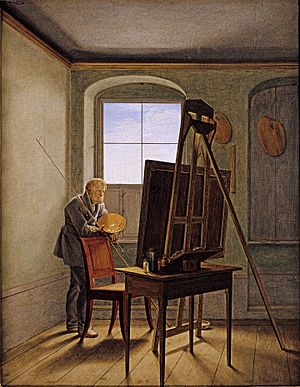Caspar David Friedrich in his studio

|
| Caspar David Friedrich in his studio (Berlin picture) |
|---|
| Georg Friedrich Kersting , around 1812 |
| Oil on canvas |
| 51 × 40 cm |
| Old National Gallery |
With Caspar David Friedrich in his studio , the painter Georg Friedrich Kersting titled three variants of a picture that were created between 1811 and 1819. All show the romantic Caspar David Friedrich in his studio.
Berlin picture
The version called “Berliner Bild” shows the painter leaning on a chair while he is looking at the picture he is working on.
It is not possible to look at the picture as it is shown on the easel from the back. Friedrich seems lost in thought and holds his brush in his right hand , the palette , a paint stick and other brushes in his left .
Since Friedrich is known as a landscape painter, it is surprising that there is no reference to the outside world in his studio . One window is completely darkened with wooden shutters, the other only the upper two thirds are open, so that only a piece of sky can be seen.
The studio is emphatically sparse. Two more pallets, a tear strip and a triangle are just hanging on the wall .
Caspar David Friedrich sought seclusion so that he could go about his work undisturbed.
Kersting shows painting as a process of contemplation and reflection. The studio serves as a place of pure concentration. It is not what Friedrich paints that is important, but the attitude with which he creates his work.
In the Berlin picture, a chair leg covers the feet and the shoes. There is no longer a door to be seen, which makes the room even more closed. The most important thing, however, is the rotation of the easel, because it prevents the viewer from seeing what Friedrich is working on. The picture has probably progressed so far that the drawings could be cleared aside and the painter checked the overall effect critically.
Everything that could distract has been put away. The emptiness suggests meditation. The painter Karl von Kügelgen writes:
- Even the well-justified paint box along with oil bottles and paint rags was relegated to the next room, because Friedrich was of the opinion that all external objects interfere with the world of images inside ...
The doctor and natural scientist Carl Gustav Carus describes this work process as follows:
- He never made sketches, cardboard boxes or color sketches for his paintings because he maintained (and certainly not entirely wrong) that these aids always cool the imagination a little. He didn't start the picture until it was alive before his soul ...
Friedrich himself did not explain anything and concluded. He spoke of his work in the studio and wrote about the consecrated hour , during which he did not want to be disturbed.
Kügelgen wondered what the tear rail was supposed to be, which was the only wall decoration on the wall and nobody could understand how it got the honor . The reason was that rulers and triangles are part of the sobriety of this studio and Friedrich's working method, in which a lot of mathematics was hidden.
Friedrich's Dresden studio was located in the Pirnaische Vorstadt on the street An der Elbe, which is now called Terrassenufer . He worked here until 1820. From two sepia leaves from 1805/06 it can be seen that the windows of the studio overlooked the Elbe . Friedrich did not construct the wooden shutters until after 1806 and, after he was married and his first daughter was born, he took them with him to the larger apartment a few houses away. In the new studio space, these shutters can be seen in the picture Woman at the Window from 1822.
Hamburger image
In the version from 1811, which is referred to as the Hamburg picture, Friedrich sits in front of the easel and paints with his arm on the painting stick. In this case it can be seen that he is working on a mountain landscape with a waterfall.
In the Hamburg picture, Friedrich paints sitting, wearing a house skirt and slippers, which gives the picture something private.
Mannheim picture
The version from 1819, which is now in the Mannheim Kunsthalle , is a replica of the picture in the Hamburger Kunsthalle with a different color scheme and a few different details.
Georg Friedrich Kersting
Georg Friedrich Kersting belonged to Friedrich's circle of friends in Dresden, came from Mecklenburg and had studied under the same teachers at the Copenhagen Academy from 1805 to 1808 before settling in Dresden. In the summer of 1810, Kersting accompanied Friedrich on a hike through the Giant Mountains . He presumably also appears as a back figure in Friedrich's drawings and watercolors. In 1818, Kersting became head of the painting department at the porcelain factory in Meißen , but kept in touch with Friedrich for a while. Kerstings preferred to design his portraits as interior pictures and depicted the portrayed surrounded by familiar things that said something about him. But none of his pictures was as sparse as the portrait of his famous friend Friedrich.
It differs enormously from the “chaotic study” of the painter Gerhard von Kügelgen , which was crammed with countless objects.
literature
- Wieland Schmied (ed.): Harenberg Museum of Painting: 525 masterpieces from seven centuries , Harenberg Lexikon Verlag, Dortmund 1999. ISBN 3-611-00814-1
- Wieland Schmied: Caspar David Friedrich , DuMont Buchverlag, Cologne 1992. ISBN 3-8321-7207-6
- Norbert Wolf : Caspar David Friedrich - The painter of silence , Taschen Verlag, Cologne 2003. ISBN 3-82281957-3


